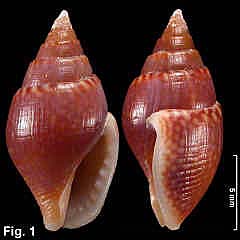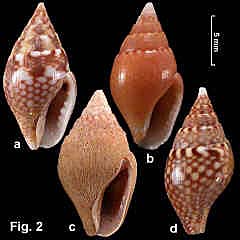|
|
|
|
|
Pardalina testudinaria (Link, 1807) Description: Shell solid, spire slightly convex to slightly concave in outline; whorls shouldered, rounded or straight below shoulder; aperture about half shell length. Axial sculpture absent; spiral sculpture restricted to about 6-12 cords on base. Outer lip of aperture sinuous with wide, shallow sinus posteriorly; thickened externally and internally, with 6-8 denticles in centre. Columella callous sharp-edged with weak denticles in mature shells. Anterior canal not upturned, siphonal notch shallow. Colour extremely variable; dark brown to orange to white, with axial streaks or dots in quincunx. Periostracum thick, axially lamellate, brown. Size: Up to 19 mm in length, commonly about 12 mm. Distribution: Indo-West Pacific; in Australia, Abrolhos Islands, WA, around northern Australia to Sydney, NSW. Habitat: Intertidal, on rocky shores. Common in the tropics and in northern NSW, rare south of Woolgoolga. Comparison: This is similar to the two species of Pyrene found in NSW, but is smaller and the spire is concave to weakly convex; in Pyrene the spire is strongly convex. It is much more common than the Pyrene species. Synonymy: This species is very variable in shell shape and colour. Cernohorsky (1972) lists 17 synonyms; those which have been used in recent Australian literature are vulpecula Sowerby, 1844 and tylerae Gray in Griffith & Pidgeon, 1834. Fig. 1: Broomes Head, NSW (DLB5123) Fig. 2: a. South Keppel Is., Queensland (C.376117) b,c. Broomes Head, NSW (DLB5123) d. Minnie Waters, NSW (DLB4903) |

